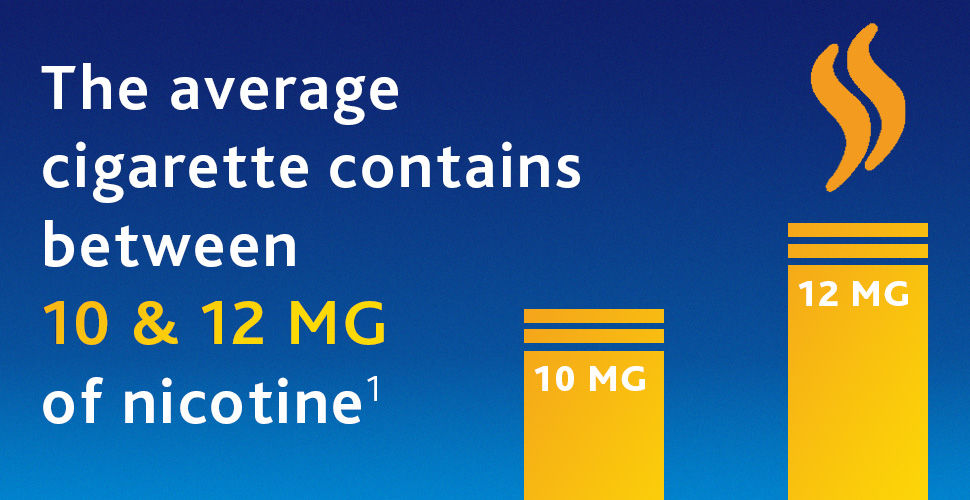On average, cigarettes contain between 10mg and 12mg of nicotine, but how much nicotine is in a cigarette can vary greatly between different brands and makes. Whilst some brands can contain up to 28mg of nicotine per cigarette, it is typical for between only 1.1mg and 1.8mg of nicotine per cigarette to enter the bloodstream, as a large quantity is lost in the burning process. [1]

What Is in a Cigarette?
Most people know that cigarettes contain nicotine and tobacco, two substances that can have a big impact on your heart, lungs and overall health. However, you may not know that there are many other harmful chemicals in cigarettes that can affect your body.
Here, we take a look at what ingredients go into a cigarette and how these different components can affect your health over time. So, if you’re wondering how cigarettes are made, keep reading.
How are cigarettes made?
Cigarettes are made using a combination of tobacco leaf, other ingredients and additives, as well as structural materials. Different types of tobacco leaf are selected, and then blended and processed with the other ingredients to create a cut tobacco mix. This mixture is finally laid onto a long spool of cigarette paper, which, with the addition of filters and adhesive, is wrapped and cut into individual cigarettes. [2]
So apart from tobacco, what is in a cigarette?
Nicotine
Nicotine is a chemical stimulant that occurs naturally in tobacco leaves and makes smoking cigarettes addictive.
What does nicotine do?
When it’s absorbed into the bloodstream, nicotine creates a pleasurable “kick” and releases the hormone beta-endorphin, which inhibits pain receptors.[3] It also releases dopamine, a neurotransmitter that is vital to our brain’s reward response. This means that smoking a cigarette can briefly feel pleasurable and energising.[4]
After smoking a cigarette, nicotine levels in the blood gradually fade, and the “pleasurable” feeling of smoking fades with them. This creates an urge to consume more nicotine to feel “normal”, which is why quitting cigarettes cold-turkey can be so difficult. In fact, the NHS says that only 3 in 100 people can quit smoking this way. [5]
Nicotine is also one of the most harmful chemicals in cigarettes for our bodies. Just some of the health effects include:
- high blood pressure caused by constricted blood vessels
- increased risk of stroke and heart attack from higher blood pressure and damaged blood vessels
- increased risk of lung diseases
- Skin damage from reduced blood flow [2]
Because it is so addictive, nicotine also poses a risk to your health by encouraging people to continue smoking and subsequently consuming all the other harmful chemicals in cigarettes.
Carbon Monoxide
While carbon monoxide isn’t added to tobacco during the manufacturing process, it is formed when cigarettes are smoked. [6]
When carbon monoxide enters the bloodstream, it takes the place of oxygen, meaning less oxygen is getting transported to your vital organs. Less oxygen means more strain on your heart and lungs as they work harder to keep the body oxygenated, and this extra stress increases the likelihood of stroke and heart disease for smokers. [7]
Tar
Tar is another by-product of burning tobacco and is the dark substance that can be seen on smokers’ fingers. Not only is it carcinogenic (which means it causes cancer), but it also clogs up the bronchioles. These are the many small airways in our lungs, responsible for absorbing oxygen and releasing carbon dioxide. Blocked bronchioles can make breathing harder, damage the lungs and increase the risk of lung cancer and other lung problems. [8]
Other bad ingredients in cigarettes
Cigarette manufacturing companies frequently add chemicals and other ingredients to their cigarettes. The purpose of these cigarette ingredients can vary, from altering the taste and texture of tobacco to making cigarettes more addictive.
When these additives are burned, they can release over 7,000 chemicals. At least 69 are carcinogenic[9], and many more are toxic or harmful in other ways. [10]
The carcinogenic chemicals in cigarettes can damage the DNA in our cells, leading to them developing in unexpected ways, which is how cancer forms.[11]
The health risks associated with the other bad ingredients in cigarettes are also severe. The World Health Organisation (WHO) has identified that the consumption of these chemicals and other tobacco products is fatal to half of all tobacco users. This amounts to 8 million people a year, including 1.2 million people who are exposed to second-hand smoke. [12]
Other common harmful cigarette ingredients include:
- Acetone – found in nail polish remover
- Acetic Acid – an ingredient in hair dye
- Ammonia – A common household cleaner
- Arsenic – Used in rat poison
- Benzene – found in rubber cement and gasoline
- Butane – Used in lighter fluid
- Cadmium – the active component in battery acid
- Formaldehyde – embalming fluid
- Hexamine – found in barbecue lighter fluid
- Lead – used in batteries
- Naphthalene – an ingredient in mothballs
- Methanol – a main component in rocket fuel
- Toluene – used to manufacture paint [9]
Quitting Smoking to Improve Your Health
Smoking cigarettes poses many serious health risks. Addictive cigarette ingredients can make it difficult for smokers to quit, even if they know that tobacco smoke is dangerous to them and those around them.
Fortunately, there are a range of services and products out there that make it easier to quit smoking and leave behind the harmful chemicals found in cigarettes.
The NHS have a variety of useful services to help you quit. These can be found online or at your local pharmacy. Nicotine Replacement Therapy products are another option that can be found at many pharmacies and supermarkets and can help you cope with cravings as you start your quitting journey.















